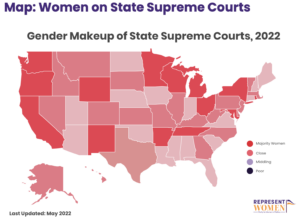Weekend Reading on Women’s Representation: Affirmative Action and the Supreme Court; Ranked-Choice Voting Reaches Arlington, Va.
Originally published by RepresentWomen for Ms. Magazine
This week of June is packed with historic firsts and anniversaries.
- Ranked-choice voting was used in Arlington County for the first time.
- Juneteenth and the anniversary of Title IX have all happened this week.
- Tomorrow marks one year since Roe v. Wade was overturned.
As we strive for equality, it is essential to remember both the progress and the setbacks we have faced, so that we can be pragmatic about the work ahead.
Ranked-Choice Voting Reaches Arlington County, Virginia
This past Tuesday, Arlington County debuted ranked-choice voting for its board elections and the Virginia Democratic primary. Voters have ranked their top three options of candidates. If their candidate of choice gets 33.3 percent of the vote, they will have a spot on the general election ballot. In order to prevent any other candidates from receiving a larger vote share, a minimum of 33.3 percent is required for any candidate.
Ranked-choice voting will help reassure voters that they can vote for the candidate they want rather than who they think will win. While the results of this election are not known yet, we do know that ranked-choice voting has helped women win in other places, such as New York City.
Proportional RCV is a multi-winner version of RCV and is a great way to select nominees that fully represent the primary electorate. In Arlington, voters will rank up to three candidates in order of preference. For a candidate to secure a place on the general election ballot, they need 33.3% of votes – the point at which mathematically, no two other candidates can surpass their vote share.
If no two candidates win 33.3% of voters’ first-choice support, backup choices come into play. If your favorite candidate performed poorly or you already helped your first choice surpass 33.3%, your vote can help your second choice reach the threshold (and so on until two candidates are nominated). As a result, a vast majority of voters (at least 66.6%) will help nominate a candidate they support, and the nominees will be reflective of voters’ preferences. In the last competitive 2-seat county board primary in 2015, the top two winners combined earned only 45% of the vote.
In fact, in past U.S. elections that have used proportional RCV, over 90% of voters see one of their top three choices win a seat – showing that RCV better reflects the will of the voters even if their favorite candidate does not win. Compare this to other election methods, where only 30 or 40% of voters may see their votes elect a winner.
Affirmative Action and the Supreme Court: ‘White Women Should Pay it Forward’
As of this week, the Supreme Court has two cases on its docket that will determine the future of affirmative action. Although affirmative action policies are typically discussed in reference to racial and ethnic minorities, white women have been among the largest beneficiaries.
In her New York Times opinion piece, Judge Scheindlin, who served on the United States District Court for the Southern District of New York from 1994 to 2016, calls for white women to reaffirm the policies that have helped so many achieve positions of leadership.
We rightly celebrate the achievements of women and people of color on the bench. The federal judiciary, for example, now has the first Black female Supreme Court justice, the first Black female judge on the United States Court of Appeals for the 11th Circuit, and the first Latino judge on the Court of Appeals for the District of Columbia Circuit. And the nomination of the first Latina judge to sit on the Court of Appeals for the Fifth Circuit is pending in the Senate.
But there is still more progress to be made, in the courts and beyond, especially for women of color who face unique barriers because of sexism and racism. White women must leverage the privilege and positions they have achieved and stand alongside communities of color.
We have an obligation to recommend, hire, promote, nominate, and honor not only those who look like us but also those who do not. If we all do that only twice in our careers, we will have gone beyond merely talking about diversity to achieving the goal of creating a country in which opportunity and advancement are open to all.
The social fabric of universities, and consequently our greater society and our democracy, depends on it.
